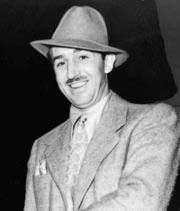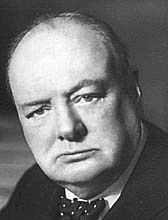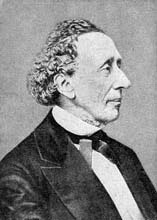Famous People With Dyslexia: Walt
Disney and More…

Walter Elias "Walt" Disney was an American film producer, director, screenwriter, voice actor, and animator. One of the most well-known motion picture producers in the world, Disney was also the cartoon artist of comic books and newspaper comic strips, the creator of an American-based theme park called Disneyland, and was the co-founder with his brother Roy O. Disney of Walt Disney Productions, the profitable corporation now known as The Walt Disney Company.
Walt Disney is in particular noted for being a successful storyteller, a hands-on film producer, and a popular showman. He and his staff created a number of the world's most popular animated properties, including the one many consider Disney's alter ego, Mickey Mouse.
Walt Disney is also remembered for his dyslexia, or so it is claimed on numerous websites on the Internet, and in a cover story in Time Magazine, a story to which the Walt Disney Family Museum responded:
"Experts about dyslexia are learning more and more about this problem and ways to treat it. It's clear that while dyslexics have difficulties learning to read, they are often very bright — even extraordinary.
"The cover story in the July 28 issue of Time Magazine thoroughly and articulately gives readers a solid understanding of the current state of understanding about dyslexia. It points to a number of 'role models,' who are dyslexic including Tom Cruise, Whoopi Goldberg and Jay Leno.
"Why are we mentioning this in the Walt Disney Family Museum? Because Walt Disney is also on Time Magazine's list of prominent dyslexics. And there's a problem with that. Walt was not dyslexic.
"Says Dave Smith, Director of the Walt Disney Archives, 'There is no indication anywhere in Walt's history that he ever had dyslexia, either in his childhood or during his business career.'
"dys-lex-ia\ n: 'an affliction affecting a person's ability to read, usually associated with a mental process that causes distorted perceptions of letters and words.'
"The reputable biographies of Walt make no reference to his having dyslexia. He never made reference to any difficulty reading and he wrote fluidly. His difficulties in school — which may have led one to think there was some kind of learning disability — were almost certainly tied to fatigue. From age ten on, Walt was up before dawn delivering newspapers before school. What's more, he had a variety of other jobs that took his time and kept him from concentrating on schoolwork.
"In fact, had Walt suffered from this syndrome, the Family Museum would happily boast about the fact, and make certain that he was a known role model for young people battling with the obstacles dyslexia can present.
"But given the number of myths that exist about Walt, it is nonetheless disturbing to witness yet another one entering the public mind. We called Time, and asked how they reached their conclusion. The short answer: The magazine assembled already-published lists of people with dyslexia. Then they did an Internet search of those people, and where they found any refutation of this idea (as with Albert Einstein) they took them out of the list. The remainder, they assumed, had dyslexia.
"To be sure, there are scores of references on the Internet that link Walt and dyslexia. Many are from respectable organizations. But repetition without refutation is hardly a sign of anything other than widespread ignorance.
"It is an honor of sorts that these groups want to claim Walt as a role model. But, honor or not, it doesn't make it true. And one of the primary goals of the Family Museum is helping to obliterate myths — even complimentary ones — about Walt Disney, in order to preserve the truth about the man and his legacy."
Winston Churchill

Sir Winston Leonard Spencer Churchill (1874 – 1965) was a British politician known chiefly for his leadership of the United Kingdom during World War II. He served as Prime Minister of the United Kingdom from 1940 to 1945 and again from 1951 to 1955. A noted statesman and orator, Churchill was also an officer in the British Army, a historical writer, and an artist. He is also remembered for his dyslexia.
According to The Churchill Centre, however, Winston Churchill was not dyslexic and had no learning disability whatsoever: "In his autobiography he played up his low grades at Harrow, undoubtedly to convince readers, and possibly himself, how much he had overcome; but in this he exaggerated. He was actually quite good at subjects he enjoyed and in fact won several school prizes. The best source on his actual school performance is Jim Golland's Not William — Just Winston (Harrow: 1988), still available from the Harrow School Bookshop."
Churchill began his literary career at the age of 24 with campaign reports: The Story of the Malakand Field Force (1898) and The River War (1899), an account of the campaign in the Sudan and the Battle of Omdurman. In 1900, he published his only novel, Savrola, and, six years later, his first major work, the biography of his father, Lord Randolph Churchill. His other famous biography, the life of his great ancestor, the Duke of Marlborough, was published in four volumes between 1933 and 1938. Churchill's history of the First World War appeared in four volumes under the title of The World Crisis (1923-29); his memoirs of the Second World War ran to six volumes (1948-1953/54). After his retirement from office, Churchill wrote A History of the English-speaking Peoples (4 vols., 1956-58). His magnificent oratory survives in a dozen volumes of speeches, among them The Unrelenting Struggle (1942), The Dawn of Liberation (1945), and Victory (1946). Churchill, a gifted amateur painter, also wrote Painting as a Pastime (1948). An autobiographical account of his youth, My Early Life, appeared in 1930.
To be exact, Churchill wrote a total of 43 book-length works and received the Nobel prize in literature in 1953.
The disability he did suffer from was a lisp — not a stutter, as some believe. He was unable to pronounce the letter "s." He fought to overcome this but never quite succeeded. Instead, he gradually made it a distinctive part of his oratory, turning a liability to an asset. This is certainly something young people should find motivating, but it is inaccurate to suggest that he had dyslexia.
Hans Christian Andersen

Hans Christian Andersen was a Danish author and poet, most famous for his fairy tales. Among his best-known stories are The Steadfast Tin Soldier, The Snow Queen, The Little Mermaid, Thumbelina, The Little Match Girl, The Ugly Duckling and The Red Shoes. During Andersen's lifetime he was feted by royalty and acclaimed for having brought joy to children across Europe. His fairy tales have been translated into over 150 languages and continue to be published in millions of copies all over the world.
Andersen was, according to many sources on the Internet and even scholarly books like Corinne Roth Smith's Learning Disabilities. The Interaction of Learner, Task, and Setting (Boston: Allyn and Bacon, 1991), also dyslexic.
Born in 1805 as the son of Hans Andersen, a poor but self-educated shoemaker, and Anne Marie Andersdatter, an illiterate washerwoman, Andersen grew up in the slums of Odense. From 1810-11, he attended two "pogeskoler" (infant schools). After that, his school attendance was somewhat haphazard, especially after the death of his father in 1816. His mother sent the 11-year-old to work in a tailor's shop and later a tobacco factory to help support the family. Unhappy with these jobs, he left home at the age of fourteen to seek his fortune in Copenhagen.
As a young teenager, Andersen became quite well known in Odense as a reciter of drama and as a singer. Although determined to become a national success on the stage, Hans failed miserably, but made some influential friends in Copenhagen who got him into school to remedy his lack of proper education.
In 1822 Jonas Collin, one of the directors of the Royal Theatre and an influential government official, gave Andersen a grant to enter the grammar school at Slagelse. He lived in the home of the school headmaster Meisling, who was annoyed at the oversensitive student and tried to harden his character. Other pupils were much younger, 11-year-olds, among whom the six years older Andersen was definitely overgrown. His appearance also drew unwanted attention — he had a long nose and close-set eyes.
In 1827 Collin arranged private tuition for Andersen, and he gained admission to Copenhagen University, where he completed his education.
In 1829 Andersen gained his first success, not as an actor but as a writer, with A Walk From Holmen's Canal to the East Point of the Island of Amager in the Years 1828 and 1829. Despite its unwieldy travelogue title, this was a tale of fantasy inspired by the work of E. T. A. Hoffmann.
Although today Andersen is primarily known as a writer of stories for children, during his lifetime he was also celebrated for his other literary works, including six novels, five travel journals, three autobiographies, and numerous poems and plays. According to Terri Windling, "the modern image of Andersen (as portrayed in the sugary 1952 film Hans Christian Andersen, starring Danny Kaye) is of a simple, innocent, child-like spinner of tales, a character from one of his own stories. Letters and diaries by Andersen and his contemporaries, however, draw the picture of a very different man: a sharply intelligent, ambitious writer with a hardscrabble past, a love of high society, and a tortured soul. Likewise, Andersen's fairy tales, when read in the original Danish (or in good, unabridged translations), are far more sophisticated and multi-layered than the simple children's fables they've become in all too many translated editions, retellings, and media adaptations. The writer was no innocent naïf recounting fancies whispered by the fairies; he was a serious artist, a skillful literary craftsman, a shrewd observer of human nature and of the social scene of nineteenth century Denmark."
Finally, in an article, "Hans Christian Andersen's spelling and syntax: Allegations of specific dyslexia are unfounded," published in the November 2000 issue of the Journal of Learning Disabilities, Kihl, Gregersen and Sterum concluded that Andersen was not dyslexic. The article is summarized as follows: "Sources contemporary with Danish author Hans Christian Andersen claimed that he did not master the Danish language, which modern studies interpret as specific dyslexia. A systematic study of his diaries from age 20 to age 70 found a mean spelling error percentage of approximately 1.7 (SD = 1%, range = 0%-4%). A methodologically independent reliability study confirmed these figures. Andersen's error percentages in poems and letters from ages 11 to 19 show a typical initial part of a learning curve that, together with the results from the diaries, gives a life span curve of his spelling development. The diaries, letters, and poems contain only insignificant syntactic errors. Andersen's spelling in the above studies is compared with that of his contemporaries and with data from modern studies. His mean error percentages at different ages are equal to the figures from nondisabled participants, but between 2 and 15 times lower than the mean percentages in studies of individuals with dyslexia. A structural analysis of Andersen's spelling errors shows that they are mainly phonologically plausible from ages 11 to 70, and that the proportions of plausible/implausible errors match those of normal achievers, but not those of individuals with dyslexia."
|